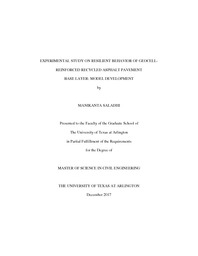
ATTENTION: The works hosted here are being migrated to a new repository that will consolidate resources, improve discoverability, and better show UTA's research impact on the global community. We will update authors as the migration progresses. Please see MavMatrix for more information.
Show simple item record
| dc.contributor.advisor | Puppala, Anand | |
| dc.creator | Saladhi, Manikanta | |
| dc.date.accessioned | 2018-02-15T20:06:38Z | |
| dc.date.available | 2018-02-15T20:06:38Z | |
| dc.date.created | 2017-12 | |
| dc.date.issued | 2017-12-14 | |
| dc.date.submitted | December 2017 | |
| dc.identifier.uri | http://hdl.handle.net/10106/27163 | |
| dc.description.abstract | Recycled Asphalt Material (RAP) is defined as removed and reprocessed pavement materials containing asphalt and aggregates. These materials are obtained when asphalt pavements are removed for the rehabilitation and maintenance of distressed pavements. The use of RAP as a base/subbase aggregate in pavement construction is technically and environmentally a sustainable solution, and conserve use of natural resources by requiring less virgin aggregate in pavement construction. Past studies showed that the use of 100% RAP as base course lacks shear strength and can undergo large deformations. Geocells are a system of three-dimensional, interconnected, honeycombed cellular structures that resist the lateral expansion of soil particles and act like a slab to distribute surface loads over a larger area of the foundation soil. Most of the recent studies on geocell-reinforced RAP bases show that they improve the pavement service life, strength and stiffness of base layer. The main objective of this research was to develop and construct a large-scale laboratory test setup, which was used to perform a series of cyclic plate load tests to examine resilient behavior of geocell-reinforced RAP bases.
Six large-scale laboratory cyclic plate load tests and two static plate load tests were conducted on unreinforced and geocell-reinforced RAP base road sections. The unpaved road sections consisted of moderate subgrade, unreinforced/geocell-reinforced RAP base, and a RAP cover. The test results showed that the geocell-reinforcement improved the performance of RAP bases. The high hoop strength of the geocell reinforcement provided more confinement and offered additional resistance against lateral movement of RAP base. The geocell reinforcement significantly reduced the permanent and resilient deformations of RAP base when compared to that of unreinforced RAP bases, thereby increasing resilient modulus of the reinforced base layer. The geocell-reinforced RAP base layer acted as a stiff mattress foundation and resulted in lower compression of RAP base and subgrade. The geocell reinforcement significantly reduced the permanent deformations of RAP base approximately by 50% when compared to that of unreinforced RAP base. Additionally, the geocell reinforcement had increased resilient modulus of RAP base by a factor of 3.0, compared to that of unreinforced RAP base. | |
| dc.format.mimetype | application/pdf | |
| dc.language.iso | en_US | |
| dc.subject | Geocell | |
| dc.subject | Recycled asphalt pavement | |
| dc.subject | Cyclic loading | |
| dc.subject | Resilient modulus | |
| dc.subject | Cyclic loading | |
| dc.title | EXPERIMENTAL STUDY ON RESILIENT BEHAVIOR OF GEOCELL-REINFORCED RECYCLED ASPHALT PAVEMENT BASE LAYER: MODEL DEVELOPMENT | |
| dc.type | Thesis | |
| dc.degree.department | Civil Engineering | |
| dc.degree.name | Master of Science in Civil Engineering | |
| dc.date.updated | 2018-02-15T20:08:45Z | |
| thesis.degree.department | Civil Engineering | |
| thesis.degree.grantor | The University of Texas at Arlington | |
| thesis.degree.level | Masters | |
| thesis.degree.name | Master of Science in Civil Engineering | |
| dc.type.material | text | |
| dc.creator.orcid | 0000-0002-5802-1555 | |
Files in this item
- Name:
- SALADHI-THESIS-2017.pdf
- Size:
- 3.418Mb
- Format:
- PDF
This item appears in the following Collection(s)
Show simple item record


